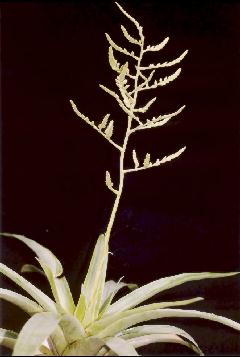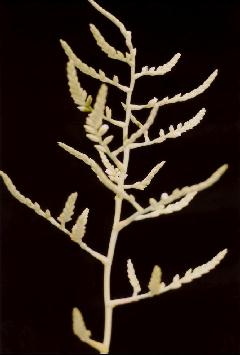

Racinaea multiflora (Bentham) M.A.Spencer & L.B.Smith, Phytologia 74: 155. 1993. BASIONYM: Tillandsia multiflora Bentham, Bot. Voy. Sulph. 174. 1844.
Revision by Eric J Gouda and Jose Manzanares in Die Brom. 3: 100-104. 2017
Edouard Andre described Tillandsia decipiens in 1888 and Lyman B. Smith gave it a new status as variety of T. multiflora in 1930. In 1933 a new variety T. multiflora var. tomensis was described in the same publication.
All taxa were transferred to Racinaea (former subgenus Pseudocatopsis of Tillandsia) by M.A. Spencer & L.B. Smith (1993). The plant habit and size of the species and all varieties resemble each other very much and also the inflorescence architecture is very similar. Differences in characteristics, which are obvious when you are comparing living specimens, may be hard to find in herbarium material because they might got lost in the drying process. Growing this species and its varieties at the Botanic Gardens Utrecht gave us the opportunity to study them in detail and to classify them.
It became clear that both var. decipiens and var. tomensis show significant differences to the typical Racinaea multiflora (Bentham 1846) Spencer & Smith (1993) and they therefore should be recognized as a species and a variety of this species on their own right.
Racinaea multiflora (Fig. 1-3) is only known from Peru and has a waxy white inflorescence with the flowers spreading to nearly 90°, more densely arranged and nearly throughout twice to thrice branched. Peduncle bracts are foliaceous, much exceeding the internodes. The lower primary bracts are about equalling the branches. The two other taxa mentioned above do not have a waxy white inflorescence. Their peduncle bracts are relatively short with the lower primary bracts much exceeded by the branches and the flowers. In R. multiflora, a yellow coloration is shining through the pale white-transparent flower base, because the petals are yellow (except the exceeding apical part which is white) and have erose crenulated margins. The petals of the other two taxa are totally white, not crenulated at the margins. Their inflorescences are green or orange-red and the flowers are less densely arranged and only divergent.
Racinaea decipiens (Andre) Gouda & Manzan. comb. nov. Die Brom. 3: 104. 2017
basionym:Tillandsia decipiens Andre Enum. Bromel. 7 (1888)
= Racinaea multiflora var. decipiens (Andre) M.A. Spencer & L. B. Sm. Phytologia 74: 155. (1993)
Typus: Ecuador: Andre 4055 (holotype K, isotype NY).
This species is totally green (Fig.4-7), except for the white petals. It grows epiphytically in dry areas from sea level up to 2400m elevation in Ecuador and Northern Peru. The typical yellow-green rosettes can be locally abundant in trees.
Racinaea decipiens (Andre) var. tomensis (Smith) Gouda & Manzan. comb. nov. Die Brom. 3: 104. 2017
basionym: Tillandsia multiflora var. tomensis L. B. Sm. Contrib. Gray Herb. 89: 13, 35 pl. 5 figs. 1-4 1930)
= Racinaea multiflora var. tomensis (L. B. Sm.) M. A. Spencer & L. B. Sm. Phytologia 74: 155. (1993).
Typus: Ecuador: Hitchcock 21357 (holotype GH, isotype US).
This variety tends to be slightly larger than the species and has a beautiful orange-red inflorescence (Fig. 8-10). It also grows in dry areas at 700 to 2400m elevation in Southern Ecuador and Northern Peru.
Cultivation: All three taxa can be grown epiphytically, are easily cultivated and flower regularly.
Desc from S&D
382b. Tillandsia multiflora var decipiens (Andre) L. B. Smith, Contr. Gray Herb. 89: 13, 35. 1930. Fig 336 L--M.
Tillandsia decipiens Andre, Enum. Bromel. 13 Dec 1888; Rev. Hortic. 60: 567. 16 Dec 1888.
Leaves 4 dm long;
Blades 25 mm wide, narrowly triangular with long caudate apices.
Scape-bracts all greatly exceeding the internodes, all with long caudate apices.
Primary bracts lanceolate, acute or short-acuminate, shorter than the axillary branches.
Type. Andre 4055 (holotype K, K photo 7438, isotype NY), Sabanetas, Los Rios, Ecuador, 11 Ju1 1876.
DISTRIBUTION. Epiphytic in forest, 10-1700 m alt, Ecuador, northwestern Peru. ECUADOR. MANABI: Jipijapa, 10 Oct 1952, Fagerlind & Wibom 560 (S, US); Cerro Monte Criste, 10 Aug 1962, Gilmartin 809 (US). GUAVAS: Balao, Mar 1892, Eggers 14576 (M, US); east of Colonche, 18 Aug 1963, Gilmartin 854 (US); km 80, Guayaquil to Quevedo, 2 Aug 1965, Gilmartin 1050 (US). ORO: Machala, Oct 1836, Barclay 524 (BM); Machala to Puerto Bolivar, 26 Aug 1923, Hitchcock 21106 (US); Puerto Jeli, 22 Mar 1955, Asplund 15876 (S, US). LOlA: Porto Velo, 29 Nov 1948, Foster 2590 (US); Puerto Boqueron to Gonzanama, 9 Oct 1955, Asplund 18110 (S, US). WITH¬OUT DEFINITE LOCALITY: Ruiz & Pavon {Tafalla} s n (BM, G). PERU. PIURA: Talara, Paita, 1925, Haught 94 (US); Bertita de Humay to Abra Porculla, Huancabamba, 12 Oct 1965, Sagastegui 5837 (TRP, US).
Desc from S&D
382c. Tillandsia multiflora var tomensis L. B. Smith, Contr. Gray Herb. 89: 13, 35,pl. 5, figs. 1-4. 1930.
Leaves 26 cm long;
Blades 25-30 mm wide, linear-lanceolate, acute or very short ¬acuminate.
Scape-bracts equaling or slightly exceeding the internodes, the upper ones apiculate, the lower short-caudate.
Primary bracts broadly lanceolate, apiculate, much shorter than the axillary branches.
Type. Hitchcock 21357 (holotype GH, isotype US), El Tambo to La Toma, Loja, Ecuador, 3 Sep 1923.
DISTRIBUTION. Epiphytic in woods 20-2300 m alt, Ecuador, northern Peru. ECUADOR. GUAVAS: Guayaquil, 1964, Valverde 454 (US). ORO: Rio Calera, Zaruma, 21 Aug 1947, Espinosa E-1839 (US). PERU. PIURA: Puente Tandopa, Rio Quiroz, Ayabaca, 24 Sep 1964, Hutchison & Wright 6691 (UC, US). LAMBAVEQUE: Olmos, Rauh & Hirsch P-2152 (US). CAJAMCARCA: Las Chirimoyas, San Benito, Contumaza, 5 Aug 1958, Sagastegui 500 (TRP, US); Rio Magdalena, San Juan, 15 Aug 1964, Sanchez 29 (US).
From Baker 1889
158. T. decipiens Andre, Enum. 7.
Radical leaves lanceolate-setaceous, a foot long, nearly an inch broad at the middle, finely Iepidote.
Peduncle 1 ˝ -2 ft long; bract-leaves lanceolate-setaceous.
Panicle very lax, above a foot long; branch-bracts lanceolate, the lower 1 ˝ in. long; lower branches compound;
spikes dense, with a flexuose rachis;
flower-bracts ovate, acute, glabrous, as long as the calyx.
Calyx 1/5 in. long;
sepals acute.
Corolla white, very small.
Capsule cylindrical, four times the length of the calyx.
Habitat: Andes of Ecuador, at Sabanetas, Andre 4055. Near T. parviflora.
Key to the Varieties of Tillandsia multiflora
1. Leaf-blades narrowly triangular with a long caudate apex; scape-bracts all exceeding the internodes.
2. Primary bracts narrowly lanceolate, acuminate, the lower ones exceeding the axillary branches at maturity. => var multiflora
2. Primary bracts lanceolate, acute or short-acuminate, all shorter than the axillary branches. => var decipiens. Now species R. decipiens
1. Leaf-blades narrowly lanceolate, acute or short-acuminate; scape-bracts equaling or slightly exceeding the internodes. => var tomensis. Now R. decipiens var tomensis